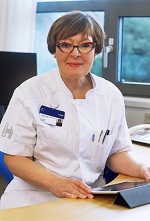Honorary Member Award 2022 Liselotte Højgaard - PDF Version
What have been the highlights of your career?
When I became head of the Department of Clinical Physiology and Nuclear Medicine at the Rigshospitalet, University of Copenhagen, in 2000, we obtained one of the first positron emission tomography (PET)/ computed tomography (CT) scanners in Europe. We started to use PET/CT for radiation therapy planning. Professor Svend Aage Engelholm, Prof Lena Specht, Dr Anne Kiil Berthelsen and Dr Annika Loft headed our PET section. This was pioneer work and important for patients. The other highlight was when Prof Malene Bjerregaard Fischer, Prof Ulrik Lassen, Prof Jann Mortensen and I, with others, published the first randomised paper on the use of PET/CT in lung cancer in the New England Journal of Medicine in 2009. Being part of the development of PET/CT in oncology for diagnosis, evaluation of treatment, follow-up and planning has been the most exciting part of my 40 years as a nuclear medicine physician.
What are you proudest of in your career?
First and foremost: the whole team in our department and the goals we reach together for our patients and in research. Then, my memberships of the European Cancer Concord and the European Academy of Cancer Sciences, where we strive for better cancer treatment for all patients in Europe and beyond. I am also proud to have chaired the European Medical Research Council at the European Science Foundation from 2006 to 2012 and the European Union Health Advisory Board during FP7 and the EU’s research and innovation funding programme from 2014 to 2020, named Horizon 2020. The calls we made were received positively by the European research medicine area. I guess this reception was due to the active inclusion of researchers in the design of the calls. I enjoyed chairing the Danish National Research Foundation from 2013 to 2018 for all areas of research. Now I am a member of the board of directors of the Novo Nordisk Foundation, which is at present the largest private charity worldwide in terms of wealth. Last year I joined the scientific council of the European Research Council (ERC). There I try to strengthen the aspects of clinical and translational science in the interdisciplinary ERC setting. On a personal basis I am very proud that I have been made a “Chevalier de la Légion d'honneur de la France“ after I spent 10 years as a member of the board of directors of the Institut national de la santé et de la recherche médicale (INSERM, the French National Institute of Health and Medical Research).
What is your next challenge?
Last autumn, we obtained one of the first new total-body PET/CT scanners, QUADRA, from Siemens. It has a 106cm field of view. The possibilities to obtain beautiful, improved images with low radiation dose and at reduced scan times, and details of the kinetics of total body organ function and blood flow, are breathtaking. Breath-hold PET/CT for planning has been installed on it. Our next aim is to release the full potential of this new fantastic scanner. A young professor, Malene Fischer, has returned to our department to head this new endeavour after three years at Kings’ College Hospital in London. We also face a positive challenge with our new section for artificial intelligence (AI) and clinically applied AI, to improve imaging through the use of AI. This section employs post-doc Claes Nøhr Ladefoged, associate prof Flemming Andersen and a young, interdisciplinary team. Dr Ladefoged solved a problem we had with the brain PET/ MRI reconstructions, and it is a privilege to work with these brilliant young people as a supervisor of masters and PhD students.
What started your interest in science?
When I was a medical student more than 40 years ago, both my husband and I started to do research. Our interest in better patient treatment, driven by curiosity, has been a lifelong companion for both of us.
Did your parents encourage you in your career, or would they rather you had done something else?
My father was a pathologist, my mother a dentist and dental anthropologist. Medical research was part of the family fabric.
What do you do in your spare time?
I read books, listen to classical music, and cook for the family, with granddaughter Ingrid as the most frequent, favourite guest. I also enjoy being an elected member of the Royal Danish Academy of Sciences and Letters, where I attend lectures in all research areas, including philosophy and theology. These help to recharge the batteries.

Professor Liselotte Højgaard, MD DMSc
Head of Department Clinical Physiology, Nuclear Medicine & PET
Rigshospitalet, University of Copenhagen;
Professor, University of Copenhagen; and
Adjunct professor, Technical University of Denmark
Copenhagen, Denmark